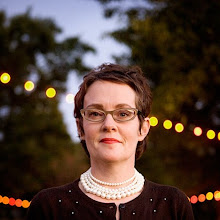
© Maurizio Cattelan, 1998
Photo: Marilu Knode
We're awaiting the installation of a work (nicknamed "the jellyfish") by Janet Echelman, and despite attempts to defund it last fall, the work will be the first, most significant marker of place in the city of Phoenix. I started thinking about how public art is often reviled when first installed (the Eiffel Tower, Claes Oldenburg / Coosje Van Bruggen's "Shuttlecocks" in front of the Nelson Atkins Museum in Kansas City), although later, the work becomes an icon of said city.
But so many more artists make temporary, ephemeral sculpture that provides an equally intriguing opportunity to become socially engaged in our civic discourse.
Above is a picture I took of a work (unpublished) by Maurizio Cattelan that he did for us at inova (Institute of Visual Arts) in Milwaukee many years ago (show curated by Jerome Sans). When Maurizio's first idea didn't work (he wanted to shoot bootleg movies and screen them), I spent a day with him visiting thrift shops looking for the appropriate clothes for this homeless dummy--Kenneth--which we placed by inova's front door. The public response was truly astonishing, and started me on a path towards working with more non-traditional forms of art in public places.
Responses we got with regards to Kenneth included a call from a young woman who yelled at me, saying she had been afraid to leave her house because of the homeless guy laying by our door. Colleagues on UWM-campus came by to see if they could get Kenneth into a homeless shelter. When it rained I thought to bring him inside, but real world Kenneth wouldn't necessarily have that option. Instead I put an umbrella in his hand--it blew away. One afternoon, within a space of a half-hour, students had posted a sign on Kenneth's coat, protesting the cost of rising tuition (students would go homeless, the note suggested).
Then one weekened, someone stole / kidnapped Kenneth (but left his shoes). It made national and local news. Maurizio thought maybe Kenneth was tired of the attention, or that he had started a march on Washington on behalf of the homeless. The e-mails were hysterical, and added another dimension, for me, to Maurizio's works.
Finally, someone from the Milwaukee police department called to say they had found Kenneth. The detective stopped by to talk about where and how they found him, and when he described what Kenneth was wearing, I had to stop him--they were the wrong clothes. Two missing dummies in Milwaukee at the same time? Perhaps the people (frat boys from across the street perhaps?) changed his clothes before a night on the town? So curious...
Lots of issues came up: institutional responsibility to the public, the artist and the art work; extending art's social engagement with contemporary issues; the role of documentation in preserving visual history in a community's life--these were all embodied in the figure of Kenneth.
Although these types of temporary sculptures do not garner the type of long-term iconic status of a Tour Eiffel, I find the gesture more direct and invigorating. Perhaps with the state of the art market, we'll see more of these gestures.








